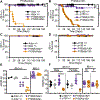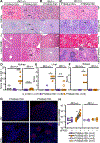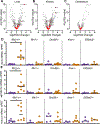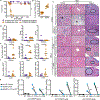Protein kinase R and the integrated stress response drive immunopathology caused by mutations in the RNA deaminase ADAR1
- PMID: 34343497
- PMCID: PMC8446335
- DOI: 10.1016/j.immuni.2021.07.001
Protein kinase R and the integrated stress response drive immunopathology caused by mutations in the RNA deaminase ADAR1
Abstract
The RNA deaminase ADAR1 is an essential negative regulator of the RNA sensor MDA5, and loss of ADAR1 function triggers inappropriate activation of MDA5 by self-RNAs. Mutations in ADAR, the gene that encodes ADAR1, cause human immune diseases, including Aicardi-Goutières syndrome (AGS). However, the mechanisms of MDA5-dependent disease pathogenesis in vivo remain unknown. Here we generated mice with a single amino acid change in ADAR1 that models the most common human ADAR AGS mutation. These Adar mutant mice developed lethal disease that required MDA5, the RIG-I-like receptor LGP2, type I interferons, and the eIF2α kinase PKR. A small-molecule inhibitor of the integrated stress response (ISR) that acts downstream of eIF2α phosphorylation prevented immunopathology and rescued the mice from mortality. These findings place PKR and the ISR as central components of immunopathology in vivo and identify therapeutic targets for treatment of human diseases associated with the ADAR1-MDA5 axis.
Keywords: ADAR1; Aicardi-Goutières syndrome; LGP2; MDA5; PKR; integrated stress response; interferons.
Copyright © 2021 Elsevier Inc. All rights reserved.
Conflict of interest statement
Declaration of interests C.S. is an employee of Calico Life Sciences and is listed as an inventor on a patent application WO2017193063 describing 2BAct. D.B.S. is a co-founder and shareholder of Danger Bio, LLC, and a scientific advisor for Related Sciences, LLC.
Figures







Similar articles
-
Human ADAR1 Prevents Endogenous RNA from Triggering Translational Shutdown.Cell. 2018 Feb 8;172(4):811-824.e14. doi: 10.1016/j.cell.2017.12.038. Epub 2018 Jan 25. Cell. 2018. PMID: 29395325 Free PMC article.
-
Mutations in the adenosine deaminase ADAR1 that prevent endogenous Z-RNA binding induce Aicardi-Goutières-syndrome-like encephalopathy.Immunity. 2021 Sep 14;54(9):1976-1988.e7. doi: 10.1016/j.immuni.2021.08.022. Immunity. 2021. PMID: 34525338
-
Aicardi-Goutières syndrome-associated mutation at ADAR1 gene locus activates innate immune response in mouse brain.J Neuroinflammation. 2021 Jul 31;18(1):169. doi: 10.1186/s12974-021-02217-9. J Neuroinflammation. 2021. PMID: 34332594 Free PMC article.
-
Effects of Aicardi-Goutières syndrome mutations predicted from ADAR-RNA structures.RNA Biol. 2017 Feb;14(2):164-170. doi: 10.1080/15476286.2016.1267097. Epub 2016 Dec 12. RNA Biol. 2017. PMID: 27937139 Free PMC article. Review.
-
Adenosine-to-inosine RNA editing in the immune system: friend or foe?Cell Mol Life Sci. 2020 Aug;77(15):2931-2948. doi: 10.1007/s00018-020-03466-2. Epub 2020 Jan 29. Cell Mol Life Sci. 2020. PMID: 31996954 Free PMC article. Review.
Cited by
-
To "Z" or not to "Z": Z-RNA, self-recognition, and the MDA5 helicase.PLoS Genet. 2021 May 13;17(5):e1009513. doi: 10.1371/journal.pgen.1009513. eCollection 2021 May. PLoS Genet. 2021. PMID: 33983939 Free PMC article. Review.
-
Z-nucleic acids: Uncovering the functions from past to present.Eur J Immunol. 2022 Nov;52(11):1700-1711. doi: 10.1002/eji.202249968. Epub 2022 Oct 10. Eur J Immunol. 2022. PMID: 36165274 Free PMC article. Review.
-
ADAR1 and ZBP1 in innate immunity, cell death, and disease.Trends Immunol. 2023 Mar;44(3):201-216. doi: 10.1016/j.it.2023.01.001. Epub 2023 Jan 27. Trends Immunol. 2023. PMID: 36710220 Free PMC article. Review.
-
ADAR1 Zα domain P195A mutation activates the MDA5-dependent RNA-sensing signaling pathway in brain without decreasing overall RNA editing.Cell Rep. 2023 Jul 25;42(7):112733. doi: 10.1016/j.celrep.2023.112733. Epub 2023 Jul 6. Cell Rep. 2023. PMID: 37421629 Free PMC article.
-
ADAR1: from basic mechanisms to inhibitors.Trends Cell Biol. 2025 Jan;35(1):59-73. doi: 10.1016/j.tcb.2024.06.006. Epub 2024 Jul 18. Trends Cell Biol. 2025. PMID: 39030076 Free PMC article. Review.
References
Publication types
MeSH terms
Substances
Supplementary concepts
Grants and funding
LinkOut - more resources
Full Text Sources
Other Literature Sources
Medical
Molecular Biology Databases

